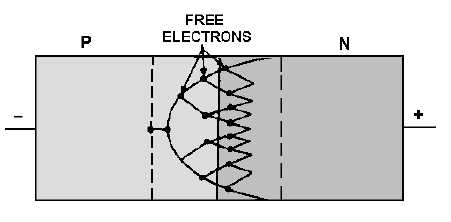3-5
resistivity of the material. Controlling the doping level of the material during the manufacturing process
can produce breakdown voltages ranging between about 2 and 200 volts.
The mechanism of avalanche breakdown is different from that of the Zener effect. In the depletion
region of a PN junction, thermal energy is responsible for the formation of electron-hole pairs. The
leakage current is caused by the movement of minority electrons, which is accelerated in the electric field
across the barrier region. As the reverse voltage across the depletion region is increased, the reverse
voltage eventually reaches a critical value. Once the critical or breakdown voltage has been reached,
sufficient energy is gained by the thermally released minority electrons to enable the electrons to rupture
covalent bonds as they collide with lattice atoms. The released electrons are also accelerated by the
electric field, resulting in the release of further electrons, and so on, in a chain or avalanche effect. This
process is illustrated in figure 3-3.
Figure 3-3.—Avalanche multiplication.
For reverse voltage slightly higher than breakdown, the avalanche effect releases an almost unlimited
number of carriers so that the diode essentially becomes a short circuit. The current flow in this region is
limited only by an external series current-limiting resistor. Operating a diode in the breakdown region
does not damage it, as long as the maximum power dissipation rating of the diode is not exceeded.
Removing the reverse voltage permits all carriers to return to their normal energy values and velocities.
Some of the symbols used to represent Zener diodes are illustrated in figure 3-4 (view A, view B,
view C, view D, and view E). Note that the polarity markings indicate electron flow is with the arrow
symbol instead of against it as in a normal PN-junction diode. This is because breakdown diodes are
operated in the reverse-bias mode, which means the current flow is by minority current carriers.


